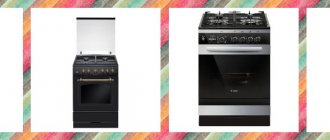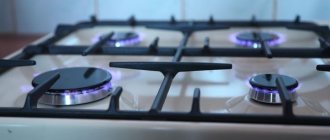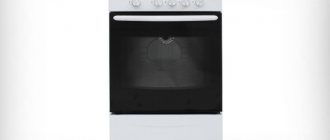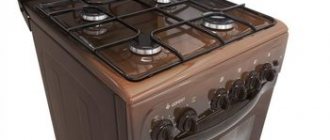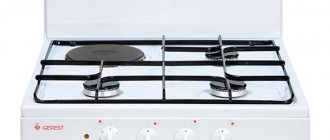Hood tasks
Any model of hood suitable for power is suitable for a gas stove.
Hoods for a gas stove perform the following functions:
- remove harmful substances and unpleasant odors from the kitchen air;
- ensure the safe operation of the gas appliance;
- maintain comfortable conditions in the chef’s work area.
When gas is burned and food is cooked, harmful substances are released into the air, which must be eliminated in a timely manner. Carbon dioxide and carbon monoxide appear when the stove is on. Increased concentrations of substances worsen your health and can cause poisoning. The process of frying foods at high temperatures is accompanied by the release of carcinogens, which, when accumulated in the body, lead to cancer.
Cooking is accompanied by the release of various odors, which spread throughout the rooms and linger for a long time, permeating the upholstery of furniture and clothing. The aromas of several dishes, when mixed, can ruin your appetite. The hood will significantly reduce the concentration of odors in the apartment.
A natural gas leak from a burner that is extinguished or not turned off cannot always be detected in a timely manner, especially during cooking. The hood will protect against explosion for some time and will help to detect a malfunction in a timely manner.
Simultaneous cooking of several dishes causes heating of the air near the stove, and hot steam creates inconvenience. Timely heat removal makes work more enjoyable. Built-in lights make working at dusk or in the dark easier.
Tips for use
- Keep the device clean and wipe it free of dust and grease after each use.
- Do not turn off the device immediately after cooking, as steam particles can spread throughout the kitchen faster than the device can absorb them. Therefore, you need to leave the hood running for a few more minutes so that it draws in all the fumes.
- Replace carbon filters regularly - at least 2 times a year.
How the devices work
For a recirculation hood, you need to buy replacement filters.
Based on the principles of operation of exhaust devices, there are varieties:
- diverting;
- recirculation;
- universal.
Devices of the first type remove harmful substances into the ventilation duct due to draft or using a fan. Separate mines are built in apartment buildings. The channels do not intersect with hoods from bathrooms and living rooms. Among all types of purifiers, diverting models have the highest performance.
The equipment operates in passive or active mode - with the fan turned on or due to natural circulation. This is convenient, since the air in the kitchen is constantly updated.
According to current sanitary and fire safety standards, not every home is allowed to install hoods with a forced operating principle. Before purchasing an exhaust hood with a fan, you should consult with the management company.
Grease trap for recirculation hood
During inspection and maintenance of a gas stove, gas service workers have the right to issue an order to dismantle the device with forced circulation. The requirement does not apply to apartments on upper floors.
Recirculation models are equipped with filters. The air passing through the device is cleaned of harmful impurities. There is no connection to the entrance ventilation duct. An important disadvantage of recirculation models is the need to replace or wash filter elements, which entails some operating costs.
First-stage filters that catch grease can be non-woven, paper, synthetic padding - they are disposable and must be replaced 5-6 times a year. Acrylic options can be washed several times in the dishwasher. The service life is limited to 1.5 - 2 years and depends on the intensity of use. Carbon filter elements are installed, as a rule, in universal devices that operate for air removal and filtration.
Combined devices operate in two modes simultaneously or it is possible to use one of them. The devices are powerful and provide maximum air purification.
Hoods for gas stoves: connection, installation
Let's look at how to properly install a hood over a gas stove at the lowest cost.
The hood should not be connected to the entrance to the ventilation shaft itself, so as not to disrupt the overall ventilation system of the apartment. The connection can be made to a special outlet for hoods, which is often equipped in the kitchens of modern buildings, or in its absence, the air outlet must be made through the outer wall.
Before installation, it is necessary to study the passports of the stove and exhaust equipment. If the passports indicate different heights of the hood above the gas stove, then preference is given to the data in the stove passport. If there is no data in the slab passport, you can rely on the height value of 0.75...0.85 meters from the slab to the hood.
The hood is installed in accordance with the requirements of its passport. Before work, prepare tools, fasteners, air ducts, adapters, clamps, studs or mounting brackets.
Attention. To prevent cold air from entering the kitchen, the air duct is routed outside the outer wall of the room through a check valve.
The following tools are commonly used:
- powerful drill;
- convenient screwdriver;
- hacksaw;
- roulette;
- pencil;
- sealant;
- level.
Installation secrets
The hood is installed after installing the gas hob. Initially, the location of the hood above the gas stove and the route of the air ducts are outlined. When installing built-in models, a hole is made in the cabinet for the air ducts to exit. Raise the bottom shelf, freeing up space for the model, and install it using self-tapping screws.
When installing models of other types, special brackets or studs are attached to walls or ceilings and hoods are mounted on them. The hood is then connected to the ventilation outlet. For this purpose, flexible or stationary air ducts, connecting fittings, and sealant can be used. When the air duct exits the outer wall, an exit hole with a protective grille or canopy is made in advance. When connected to the air duct opening, a non-return valve is mounted at the outlet. After installation, air ducts are often covered with special plastic boxes for interior decoration purposes. Often the air duct route looks quite beautiful and does not require camouflage.
Criterias of choice
The size of the hood must correspond to the size of the hob
Before purchasing hoods, individual needs are assessed. The choice is influenced by:
- geometric dimensions of the hob;
- dome shape and installation method;
- dimensions of kitchen furniture;
- the presence of ventilation shafts into which it is permissible to connect a hood;
- specifications;
- additional functions.
Each of the parameters is taken into account individually.
Dimensions
Power is calculated based on the volume of the kitchen space.
The width and depth of the hood should be equal to or slightly larger than the size of the gas stove. In this case, the rising hot air and steam will be completely removed from the room or filtered.
Taking into account the dimensions of kitchen furniture is important for aesthetic perception. Hoods are produced in various models - this makes the choice easier.
If the use of hoods with fans is prohibited in the house, you will have to install a recirculating model.
An important technical characteristic is the performance of the electric motor.
Code of Rules 54.13330.2016 requires a minimum air exchange of 100 m3/hour for rooms with a gas stove - you should choose a hood model with a suitable fan.
Form
A variety of models of kitchen hoods
According to the external shape of the model there are:
- dome;
- flat;
- T-shaped;
- telescopic;
- inclined;
- corner.
The dome version takes up more space, but completely covers the hob.
Recirculating hoods are most often flat.
Telescopic models allow you to increase the collection area of polluted air due to the retractable section. When folded, the models are perceived as an interior detail.
A variety of telescopic hoods are “domino” models, which are cut vertically into the tabletop and pulled out as needed.
The inclined types of the device are convenient to use. The leading edge is raised up so as not to interfere with cooking.
Placement method
The most common are wall hoods, which are mounted on the wall above the gas stove.
Island models are those that are located in the center of the room.
Corner options are convenient in small-sized kitchens, when the layout requires this.
Additional functionality
Telescopic hood with manual control
In addition to performance, when purchasing, pay attention to other characteristics:
- presence of illumination of the working area;
- type of control, mechanical or electronic;
- noise level during fan operation;
- body materials.
Manual control using keys or buttons is more reliable. The electronic device allows you to select the required operating modes, for example, you can turn on the timer and the device will turn off on its own. This allows you to safely leave the house or go to bed without having to worry about the fan running continuously.
Usually, when purchasing, you can include the model you like in the window. The device data sheet indicates the noise level, which should not exceed 35 dB. It is uncomfortable to be in a room with a loud device.
Pay attention to what the device body is made of. Enameled metal is easy to clean from dirt and dust and can be washed with any household cleaner. The models are distinguished by their low cost. Stainless steel hoods are attractive in appearance, and the thickness and elasticity of the material allows you to create housings of various shapes. Cleaning will be necessary as you use it, as the surface gradually darkens. The cost is higher than that of painted products. Copper, brass, and bronze are used in design projects; hoods are sold at high prices. It will be necessary to maintain the surface in proper condition using special cleaning products.
Tempered glass best meets hygienic requirements. Combinations with non-ferrous metals highlight models in the highest price category.
Plastic housings are used in recirculating hoods. The material is subject to deformation from heating.
Selecting and installing an exhaust structure
Principle of operation
System options
Installation features
Suspended structures
Built-in devices
Island models
The efficiency of exhaust equipment depends on the correct selection and proper installation. Power, performance, hood height above the gas stove - all these parameters must strictly comply with special requirements. Otherwise, the device will not be able to fully purify the air. Therefore, we will analyze the main points of selection and installation.
General installation rules
Rules for installing hoods depending on the type of stove
Before installation, you should read the manufacturer’s recommendations, which are necessarily attached to the product data sheet.
There are several general rules:
- the minimum distance from the hob to the lower edge of the hood is 65 cm;
- it is optimal to retreat 75-80 cm, which will eliminate head impacts when cooking;
- air ducts are used in a constant shape or corrugated, which can be bent;
- there are no strict requirements for the location of air ducts; they can be hidden in cabinets;
- When purchasing, pay attention to the geometry of the outlet pipe; the channel must correspond to it.
The industry produces air ducts made of plastic. Before purchasing, it is important to find out whether it is intended for transporting hot gases.
The installation height cannot be reduced, especially for models with filters. At close distances, the electric motor heats up excessively, which reduces its service life. Heavily oil-contaminated filters can catch fire due to high temperatures.
It is not advisable to increase the distance - the suction power may not be enough for high-quality operation of the device.
It should be taken into account that during operation, corrugated channels can produce increased noise due to vibration. If the hood is located far from the entrance to the ventilation shaft, it is better to use air ducts of a constant configuration.
Calculation of the minimum required exhaust power
Before purchasing a new device for air purification in the kitchen, you should make some measurements and calculations in order to know exactly what power equipment will be able to efficiently purify the air in the kitchen.
Before purchasing a kitchen hood, it is necessary to accurately determine the volume of air in the ventilated room. Then make the calculation yourself. You can contact the seller with these measurements. It will determine the performance of the equipment. The minimum required power is determined by the formula:
Pb = Vk × 12 × 1.3 = (a × b × h) × 12 × 1.3
Where:
- Vk = (a × b × h) – kitchen volume;
- The air must be completely changed 12 times in 1 hour;
- 1.3 – actual power coefficient, it takes into account power losses when air passes through ventilation holes, filters and pipeline bends;
- Pb – design hood power.
All necessary measurements and power calculations can be made independently. It is enough to determine the length and width of the kitchen, as well as its height, using a tape measure. The numbers are written in meters. Then calculations are made using a simple calculator. By multiplying three numbers, you get the volume in cubic meters (m3). When multiplied by other coefficients, the resulting power is m3/hour.
Scheme and drawing
Model performance does not always match estimates exactly. The nearest higher value should be selected. A less powerful device costs less. But it will constantly work at maximum load, as a result of which it can quickly fail. There is also a possibility that the air will not be completely purified, and then odors will penetrate into the rooms.
Equipment with air exhaust into ventilation usually has high performance. It can be installed above an electric stove above the standard size. As a result of powerful exhaust ventilation, the kitchen and even living rooms will be completely cleaned not only from steam and grease.
Ventilation with exhaust to the outside removes moisture, carbon dioxide, and unpleasant odors from the apartment. The peculiarity of exhaust ventilation is that for its normal implementation it is necessary to ensure access of air from outside into the apartment.
Accounting for distances from the slab according to standards
You cannot install powerful equipment above a gas stove and hang it at a minimum distance from the heating elements. A close hole with a large air flow can blow out the burner flame.
Step by step instructions
Each type of hood has installation features, the observance of which allows you to use the device most efficiently.
Installation of recirculation models
After installation, it is necessary to install carbon filters.
Installation of hoods that do not require connecting air ducts is the simplest.
The operating algorithm is as follows:
- Measure and mark on the wall the location of the lower cut of the hood.
- Draw the vertical axis of the center of the device.
- The locations for drilling holes are marked using a template or applying a hood to the desired location.
- Drill holes for fasteners.
- Install dowels or anchors.
- The configuration of the upper holes, as a rule, involves hanging the hood on already screwed-in screws to hang the device.
- Screw in additional lower screws (anchor nuts).
- Install an electrical outlet.
- Install a removable filter.
The installation is completed with a trial run and testing in all provided modes.
The installation procedure does not change for tilting or sliding models.
Installation and connection of diverter type models
Sequence of actions when installing a vent hood.
For diverting models, the operating algorithm is approximately the same as described above. After completing step 8 of the previous algorithm, the air ducts are connected.
For this:
- They take the necessary measurements and draw a diagram.
- Select parts of the required size, elbows, turns.
- A grille is purchased for the air duct outlet.
- The pipe is connected to the exhaust pipe and gradually mounted towards the ventilation shaft.
- The channels are attached to the wall using clamps of a suitable size.
When installing the air duct, do not allow joints at sharp angles - this causes turbulence and reverse air flow. Keep in mind that each turn reduces productivity by about 10%.
When purchasing pipes of constant cross-section (not corrugated), preference is given to round products. They accumulate less dust and dirt than rectangular ones.
To remove air from the kitchen, it is prohibited to use ducts intended for ventilation of bathrooms and living rooms. If there is no accurate information about the purpose of the mines, contact the specialists of the management company.
Placement of island appliances
The island hood is connected to the ventilation and attached to cables.
It is most difficult to correctly install models located in the center of the kitchen - even small inaccuracies in markings and sloppy installation can ruin the attractive appearance of the structure.
Before installation, you must carefully study the features of the model and the manufacturers' recommendations. The devices are attached to the ceiling, so if it is suspended, install extension brackets.
The general installation principle is as follows:
- Using a laser level or plumb line, carefully align the center of the future hood on the ceiling.
- When installing the mounting bracket, it is important to choose fittings that can support the weight of the future structure.
- Electrical wires are brought to the installation site.
- Guides for the hood duct are attached to the bracket, having previously accurately calculated their length.
- Place and screw the fan unit to the bracket.
- Connect the fan and control unit to the network.
- The decorative casing is put on and secured to the guides.
- Install the filter unit.
Complete the installation by testing in all provided modes. If necessary, eliminate rattling and other identified deficiencies.
Features of installation in private homes
In individual housing, you can install any type of device.
If ventilation ducts are not provided for in the project, a hole is cut into the street or under the roof.
Otherwise, the installation process is the same as in the apartment. At the final stage, it is important to carry out hydro- and thermal insulation of the air duct outlet points.
Which hood is better for the kitchen and photos of coal and fat appliances
I would like to pay special attention to which coal hoods are best to pay attention to. Their main task is not only to fight fat and smoke, but also to clean the air as much as possible from excess odors; as a rule, they are placed after fatty ones. If you choose which hood cleans better: coal or grease, then the first option is certainly the leader, however, it is not without its drawbacks. When choosing an option with a carbon filter, you should be prepared for additional costs, because it will have to be changed quite often. One of the most optimal options for such a device is TEKA TL1 62 BK, because it is compact, quite powerful, but at the same time silent, has an incandescent lamp and an excellent filter system. The only compelling argument to refuse to purchase this miracle of technology may be its price.
Depending on the design of the room, variations in the placement of the device are possible. Fortunately, now there are plenty of opportunities to realize your ideas.
Before such a responsible purchase, first of all, it is worth understanding the features of the models and how they differ from each other. When choosing which hood is best to choose for the kitchen, you need to take into account that they come in different types of mounting:
- hanging;
- dome;
- built-in
All these types have their positive and negative sides. And we are not talking about resistance to high temperatures, because this is already the case by default.
Below are various photos of kitchen hoods, and which one is better in an aesthetic and visual sense, the consumer will choose:
There are completely different kitchen hoods presented here, and it is better to decide which hood you should choose after inquiring about all the issues regarding this matter.
How to bypass a gas pipe
In old houses, it may be necessary to move the stove or gas pipe.
In old houses, a common situation is when the gas pipe interferes with hanging the hood above the stove.
There are several ways to solve the problem:
- Contact the gas supply company with a request to move the pipe. The option is long and not always feasible due to existing rules. Costs can range from 10,000 rubles depending on the region.
- Move the gas stove using a hose of the required length.
- Attach wooden blocks of the required thickness to the wall above and below the pipe. Installation should be carried out on a prepared base. You must be prepared for the fact that claims may come from the gas supply organization.
- Use appropriately sized brackets. The rubber gasket under the hood will significantly reduce the noise from vibration of the switched-on electric motor.
Installing a hood is a job that you can do yourself - no special skills or abilities are required. It is important to follow the installation rules, then the effect will be noticeable immediately.
Which hood is better: the quietest options
And if the buyer is looking for which hoods are the quietest, then the information posted below will be useful.
One of the most expensive but reliable options is Asko CW4924B. Considering that the price is the only drawback, a number of advantages include quietness, thoughtful design, a timer, 4 speeds, a dishwasher-safe filter, powerful lighting and a high degree of efficiency. This is the best solution for what kind of hood is needed for any kitchen.
The only thing that is not suitable for all buyers is the size, which is 90 cm.
An alternative and cheaper model is the HANSA OKS 6726 IH. If you are wondering which inclined hood is better, you should definitely pay attention to this one. A special feature of this option is a filter contamination indicator. This also includes noiselessness, a large number of additional functions, backlight, and timer. The negative side is that the lamps often overheat.
Requirements for air ducts and electrical networks
Parameters such as air ducts and electrical networks directly affect the performance of exhaust devices. That is why it is necessary to take a responsible approach to the design of ventilation ducts and electrical networks.
It should be immediately noted that for recirculation type hoods there is no need to lay ventilation pipes. They absorb air and simply filter it, after which they return it back to the room. That is why this chapter will consider the flow-through type of exhaust equipment.
If you do not plan the air exhaust system correctly, a person may get a number of the following problems:
- Changes in pressure in the channels;
- Load on the hood motor;
- Poor air permeability;
- Large air flow from the street.
To avoid this, it is best to use the help of professionals who will install ventilation ducts according to GOST standards. Only in this case will the hood be able to reveal its full potential and not cause problems during long-term use.
Also, attention must be paid to electrical networks. The position of the socket must correspond to the length of the factory hood cable. Under no circumstances is it recommended to extend the equipment wire yourself; this can lead to cable oxidation and overloading the hood.
The socket is also installed in accordance with GOST standards. It is best to plan the wiring and power points in advance after the hood has already been purchased. Of course, you can always use an extension cord.
Where to put the socket
So, in order to correctly design and install ventilation ducts, it is necessary to adhere to the basic opinions of experts, which will help increase the performance of the hood and reduce the pressure on the device’s motor.
The first thing to avoid when laying communications is excessive bends. First of all, they force the exhaust air to create additional pressure in order to deliver the exhaust air outside the house. Hence the conclusion: the fewer knees, the less force the device will need to expend to perform its basic functions. Also, the pipes must be sealed. Under no circumstances should holes be allowed in them, which could lead to a loss of pressure and, accordingly, to overload of the hood motor.
It is important to make the distance from the hood to the street as short as possible so that the exhaust device spends less energy working with a large volume of air. Also, narrowing and expansion should be avoided - the pipe must be of the same cross-section throughout its entire length, which will allow maintaining constant pressure for normal operation of the fans.
It is also recommended to install ventilation communications strictly at level. There is no need to make the air rise at an angle through the pipe; it is better to maintain a strict horizontal line and use a 90-degree elbow to move to the vertical level.
The diameter of the ventilation pipes must match the hood connector. It is best to use pipes made of environmentally friendly plastic or galvanized, they will last longer, and the cost will not hit the budget too much.
It is important to note that the installation of ventilation ducts should be carried out by a specialist who has extensive experience working with hoods and knows the basic subtleties that can improve or, conversely, worsen the performance of the exhaust device.
Distance for ventilation ducts
According to GOST standards, the outlet for the exhaust device is installed at a height of 2.5 meters from the floor level. This is the optimal indicator that specialists will use during the installation of electrical communications.
Also, it is necessary to step back 15-20 centimeters to the left or right from the hood so that the equipment body does not block the access point to the electrical network. Some hoods are connected directly to the network using terminal blocks or plugs, so installing an outlet is not always necessary.
It is very important to provide grounding for the outlet. Grounding prevents the device from burning out due to voltage surges or other unpleasant situations. Considering that some hoods cost a lot of money, it is best to take every precaution and know that the equipment will not be damaged.
If the wiring and sockets are old and the hood is already installed, you can use an extension cord. However, it is recommended to purchase an extension cord with a fuse (a device that will disconnect the carrier from the mains in the event of power surges or other situations).
Example of forced ventilation calculation
For a specific boiler and taking into account the characteristics of the room where the unit is installed, a ventilation system with certain parameters is used, the calculation of which takes into account:
- boiler power,
- room size,
- features of the heating system configuration.
Based on these factors, the method of air supply is calculated, as well as the diameter and length of the air duct.
Only accurate calculations and competent organization of the hood guarantee the efficient and safe operation of a gas boiler.
Approximate calculation for a forced ventilation system in a room 4 by 3 meters with a ceiling height of 2.2 m:
- First you need to calculate the volume of the room: 4 x 3 x 2.2 = 26.4 m³, rounded up (27 m³).
- It is important to remember that the air must be changed three times in an hour, which means that the fan power should be 81. m³ per hour. This is a calculation without taking into account the force of air resistance when passing through the chimney.
- To be accurate, add 40% to 81 m³. The result will be a figure that determines the required fan power of 113.4, when rounded - 114 m³ per hour.
We recommend that you familiarize yourself with: Rotary (angled) fitting
What types of hoods are there, and which ones are the quietest?
Information has already been provided above about what types of hoods there are, but that’s not all. We must not forget about the most modern models – inclined ones. They have a number of their own features that distinguish them from other options. Trying to understand which hoods are the quietest, you can be sure that this type of equipment ideally satisfies this requirement. It is also worth noting the replacement of the classic control panel from a push-button to a touch-sensitive one, which is more convenient in everyday life.
If we consider the question of which built-in hood is best to choose for the kitchen, then the choice largely depends on the space for placing the equipment. If space is limited, then the inclined option is best suited. The list of positive qualities includes:
- The presence of halogen lamps, the power of which is adjustable.
- Space saving due to small dimensions.
- Easy to assemble.
- Silence.
- Possibility of remote control.
Natural and forced ventilation of the boiler room
According to the method of updating the air space, natural and artificial (or forced) ventilation are distinguished.
Natural ventilation operates without the use of fans; its effectiveness is determined solely by natural draft, and, consequently, weather conditions. The draft force is influenced by two aspects: the height of the exhaust column and the temperature difference between the room and the street. In this case, the air temperature outside must be lower than that indoors. If this condition is not met, reverse draft occurs and ventilation of the boiler room is not ensured.
Forced ventilation involves the installation of additional exhaust fans.
Usually these types are combined into one boiler room exhaust system. When calculating it, it is important to take into account that the volume of air drawn outside must be equal to that pumped into the room. To ensure this condition is met, check valves are installed.
Why is ventilation needed?
The main task of the hood when using gas equipment is to remove gas combustion products from the room . The secondary purpose of ventilation is to extract gas from the room in case of leaks.
Attention! Even minimal amounts of carbon monoxide are deadly to humans. Let us also recall that a mixture of gas and oxygen is an explosive cocktail that, with an accidental spark, can turn a house into ruins.
In addition, ventilation is designed to improve equipment performance. Sufficient air flow improves gas combustion in the combustion chamber, which generally increases the efficiency of the gas unit.
If there is not the required volume of air (oxygen), then the fuel burns poorly, the amount of heat generated decreases, and the consumption of the gas mixture increases.
Thus, the organization of exhaust during boiler operation is necessary:
- for removal of carbon monoxide from the premises;
- to increase the efficiency of gas equipment;
- to remove gas from the room in case of accidental leaks.
If a powerful gas unit is used for heating, then poor exhaust quality leads to clogging of the combustion chamber. Residues of fuel combustion products clog the air duct, respectively, its internal diameter decreases and part of the carbon monoxide enters the room.
Which built-in hood to choose for a modern kitchen?
When choosing which built-in hood to choose for a modern kitchen, you should definitely pay attention to the Kamilla Sensor 600. This option is distinguished by powerful, silent operation, a filter fullness indicator that can be washed in the dishwasher, a timer, and lamps whose brightness is adjustable. And the most important advantage is the affordable price.
Another worthy representative is Bosch DFS 067K50. This German brand presented a silent, multifunctional and pleasant-looking model. In addition, it is equipped with a touch sensor, automatic switch, filter fullness indicator and a comfortable backlight system. When choosing which hood is best for a gas stove, this will be the best choice. The only downside is the price.
A more budget option is Elikor Integra 60. Representatives of small apartments will appreciate this model. It has one motor, 2 power levels, and is quite easy to use. But at the same time, the noise level exceeds the norm, and it does not have an outstanding design.
All of the above options are suitable for choosing among them which built-in hood to install in the kitchen.
Control
You can select a particular device by type of control. Typically, there are several switches located on the device panel. One is responsible for turning on the backlight, the other is needed for setting speeds, as well as turning the product on and off.
Depending on the type of control, hoods can be of several types:
- Push-button.
- Electronic.
- Sliders.
- Mechanical.
Push-button
The most familiar, classic type of control. There are buttons on the front panel or along the edging of the hood. Pressing one of them activates a specific function of the device. Pressing another button starts the next function. The previous mode is disabled and the button returns to its original position.
Electronic
There is a touch control panel on the front of the hood. The display reflects the set operating mode. Functions are switched using touch buttons.
Sliders
Conventional mechanical horizontal slide-type switches for controlling the device. By moving the slider, you can set the operating mode, turn on or off the lighting above the stove, start or stop air purification.
Mechanical
The simplest type of control. To switch, buttons or rotary switches are used. The only drawback is that grease and dirt in the fumes from the stove gets onto the raised parts of the switches, which makes them difficult to clean.
